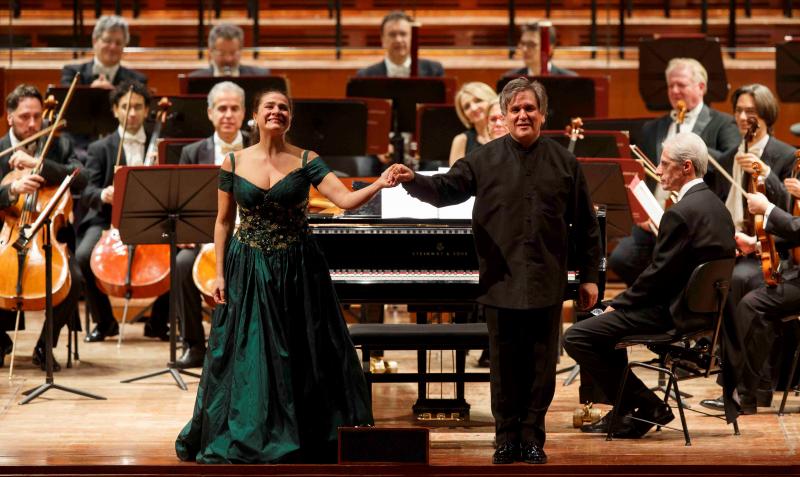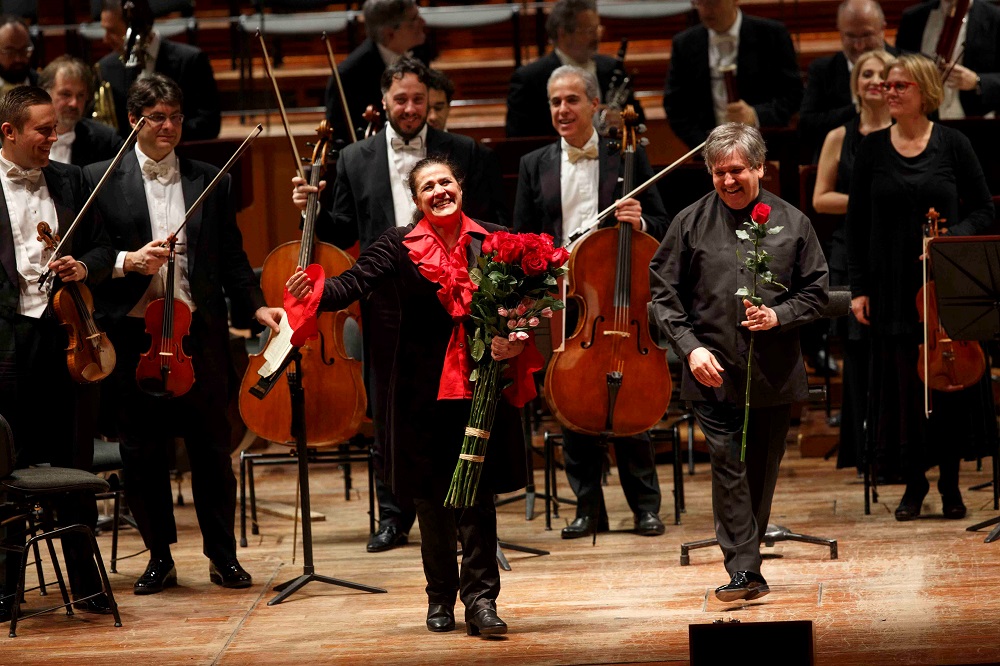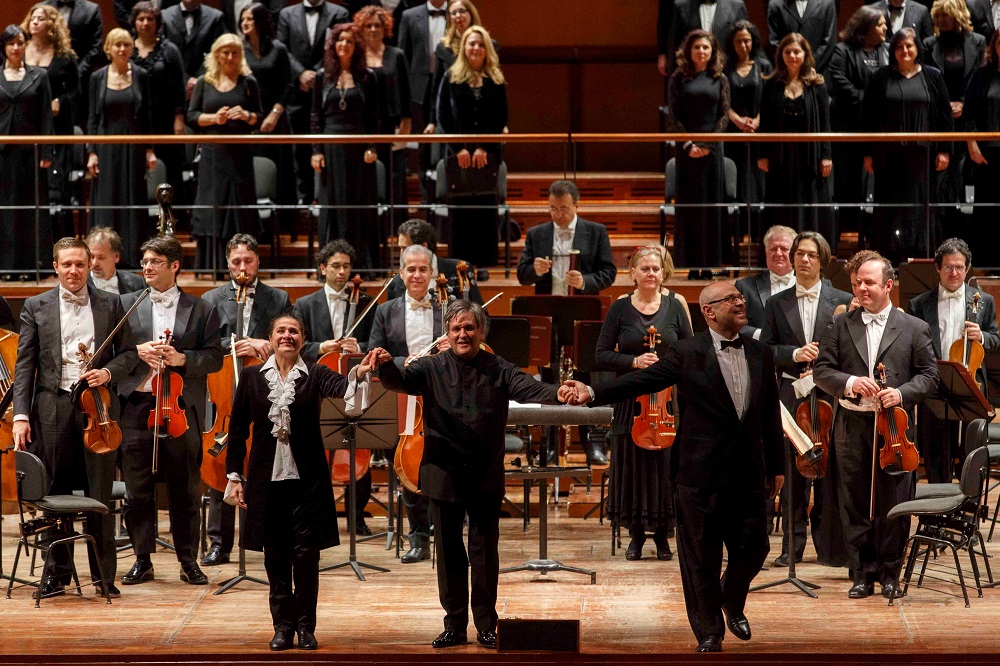theartsdesk in Rome: Bartoli and Pappano on home turf | reviews, news & interviews
theartsdesk in Rome: Bartoli and Pappano on home turf
theartsdesk in Rome: Bartoli and Pappano on home turf
Bach and Mozart in distinguished profile

Wherever you are in the world, opportunities to see Cecilia Bartoli perform are hard to come by. A one-off chance to see her sing Mozart in Rome was not to be missed. This was a rare homecoming for Bartoli. Born in Rome, she studied at the city’s Conservatorio di Santa Cecilia where many members of the orchestra teach.
These days, with due allowance made for Bellini’s Norma, she uses her fame to work in the byways of the Baroque and Classical eras with exquisitely curated studio albums, and occasional appearances in venues carefully chosen to flatter what was never a capacious, Marilyn Horne or Christa Ludwig size of mezzo-soprano.
Agreeing to appear, then, in the orchestra’s cavernous home at the Renzo Piano-designed Parco della Musica was – to put a charitable spin on it – a generous gesture. From halfway back in the stalls, one heard 50 percent Bartoli, 50 percent echo. Still, she knew her audience. And, boy, did they know her. Cries of "Evviva" rang out as soon as she appeared in the first of her four costumes for the evening. In Exsultate, jubilate, her vocal divisions flew in all directions like petals from a bouquet of brandished roses (more of them later). She still has a machine-gun lower-register that spits notes like tank shells. And she hugely over-compensated for the cavernous acoustic with a vocal personality that reached out from the stage and grabbed every audience-member by the lapels, and by some more intimate parts too. Her top C in the final "Alleluja" was nudged out mezzo-forte with the wisdom of experience.

It takes a force of nature to upstage the well-loved Antonio Pappano, no less at home here, and he ruefully acknowledged, "We have our Saint Cecilia here." But the evening was billed as a birthday party for Mozart, born 261 years ago, and the celebrations were not all about Bartoli. The first half concentrated on the sacred side of the composer’s protean musical personality, and the well-drilled Chorus of Santa Cecilia turned in performances of Misericordias Domini and Ave verum that more than made up in Verdian passion for what they may have lacked, to dessicated English ears, in Classical refinement.
Even so, the Santa Cecilia orchestra only sounded comfortable in a period skin – clipped phrasing, minimal vibrato, very sleek – once expanded to something near full strength in the second half for the "Paris" Symphony and the final fugue of the ‘’Jupiter". When I first saw this orchestra 20 years ago, in the gilt acoustic dustbin of their old home on the Via della Conciliazione, they could never have played this music with such verve and polish.
Bartoli returned in a flurry of silk blouses for two of Mozart’s loveliest concert arias, though Pappano’s obbligato piano for Ch’io mi scordi di te was almost wholly lost to the roof of the hall. She was in her operatic element for "Parto, parto" from La clemenza di Tito, where there is hardly a mezzo to touch her: certainly not her admirers, who shambled up with ever more outsize bouquets. The security guards had to prevent one elderly gentleman from clambering on stage with a jiffy bag which looked for all the world as though it held a 500-page handwritten proposal of marriage.

Rather perturbingly, hall and orchestra sounded more comfortably accommodated with each other the following afternoon, when I dropped into their recording session with the cellist Guy Johnston. He was in town to tape Respighi for the latest leg of a project (eventually to result in a disc on the King’s College Choir label) tracing the history of his cello, made almost 300 years ago in the Roman workshop of David Tecchler. A stone’s throw from the workshop, he then gave a Sunday-morning recital of the first three solo Bach Suites, at a church nestled in the crook of the Tiber.
The stone walls and handsome murals of the Oratorio del Gonfalone lent their own persuasive context to Johnston’s suggestion that the suites, considered together, trace the birth, death and resurrection of Christ. This was superbly direct Bach playing, tonally spare, unsentimental, with a sense of harmonic progress as plain and decisive as the curve of a Roman arch. By not mining every nugget of tone from the lower strings, he secured a lively speaking quality from the Tecchler: the Third Suite’s Courante gossiped away, before the weak beats of the Minuets were flicked off with a shrug.
The future of Arts Journalism
You can stop theartsdesk.com closing!
We urgently need financing to survive. Our fundraising drive has thus far raised £33,000 but we need to reach £100,000 or we will be forced to close. Please contribute here: https://gofund.me/c3f6033d
And if you can forward this information to anyone who might assist, we’d be grateful.

Subscribe to theartsdesk.com
Thank you for continuing to read our work on theartsdesk.com. For unlimited access to every article in its entirety, including our archive of more than 15,000 pieces, we're asking for £5 per month or £40 per year. We feel it's a very good deal, and hope you do too.
To take a subscription now simply click here.
And if you're looking for that extra gift for a friend or family member, why not treat them to a theartsdesk.com gift subscription?
more Classical music
 First Person: young cellist Zlatomir Fung on operatic fantasies old and new
Fresh takes on Janáček's 'Jenůfa' and Bizet's 'Carmen' are on the menu
First Person: young cellist Zlatomir Fung on operatic fantasies old and new
Fresh takes on Janáček's 'Jenůfa' and Bizet's 'Carmen' are on the menu
 Classical CDs: Chinese poetry, rollercoasters and old bookshops
Swiss contemporary music, plus two cello albums and a versatile clarinettist remembered
Classical CDs: Chinese poetry, rollercoasters and old bookshops
Swiss contemporary music, plus two cello albums and a versatile clarinettist remembered
 La Serenissima, Wigmore Hall review - a convivial guide to 18th century Bologna
This showcase for baroque trumpets was riveting throughout
La Serenissima, Wigmore Hall review - a convivial guide to 18th century Bologna
This showcase for baroque trumpets was riveting throughout
 Sheku Kanneh-Mason, Isata Kanneh-Mason, Wigmore Hall review - family fun, fire and finesse
Intimacy and empathy in a varied mixture from the star siblings
Sheku Kanneh-Mason, Isata Kanneh-Mason, Wigmore Hall review - family fun, fire and finesse
Intimacy and empathy in a varied mixture from the star siblings
 Mahler 8, LPO, Gardner, RFH review - lights on high
Perfect pacing allows climaxes to make their mark - and the visuals aren’t bad, either
Mahler 8, LPO, Gardner, RFH review - lights on high
Perfect pacing allows climaxes to make their mark - and the visuals aren’t bad, either
 Philharmonia, Alsop, RFH / Levit, Abramović, QEH review - misalliance and magical marathon
Kentridge’s film for Shostakovich 10 goes its own way, but a master compels in his 13th hour of Satie
Philharmonia, Alsop, RFH / Levit, Abramović, QEH review - misalliance and magical marathon
Kentridge’s film for Shostakovich 10 goes its own way, but a master compels in his 13th hour of Satie
 Bach St John Passion, Academy of Ancient Music, Cummings, Barbican review - conscience against conformism
In an age of hate-fuelled pile-ons, Bach's gospel tragedy strikes even deeper
Bach St John Passion, Academy of Ancient Music, Cummings, Barbican review - conscience against conformism
In an age of hate-fuelled pile-ons, Bach's gospel tragedy strikes even deeper
 MacMillan St John Passion, Boylan, National Symphony Orchestra & Chorus, Hill, NCH Dublin review - flares around a fine Christ
Young Irish baritone pulls focus in blazing performance of a 21st century classic
MacMillan St John Passion, Boylan, National Symphony Orchestra & Chorus, Hill, NCH Dublin review - flares around a fine Christ
Young Irish baritone pulls focus in blazing performance of a 21st century classic
 Classical CDs: Romance, reforestation and a Rolleiflex
New music for choir, orchestra and string quartet, plus a tribute to a rediscovered photographer
Classical CDs: Romance, reforestation and a Rolleiflex
New music for choir, orchestra and string quartet, plus a tribute to a rediscovered photographer
 First Person: St John's College choral conductor Christopher Gray on recording 'Lament & Liberation'
A showcase for contemporary choral works appropriate to this time
First Person: St John's College choral conductor Christopher Gray on recording 'Lament & Liberation'
A showcase for contemporary choral works appropriate to this time
 Donohoe, RPO, Brabbins, Cadogan Hall review - rarely heard British piano concerto
Welcome chance to hear a Bliss rarity alongside better-known British classics
Donohoe, RPO, Brabbins, Cadogan Hall review - rarely heard British piano concerto
Welcome chance to hear a Bliss rarity alongside better-known British classics
 London Choral Sinfonia, Waldron, Smith Square Hall review - contemporary choral classics alongside an ambitious premiere
An impassioned response to the climate crisis was slightly hamstrung by its text
London Choral Sinfonia, Waldron, Smith Square Hall review - contemporary choral classics alongside an ambitious premiere
An impassioned response to the climate crisis was slightly hamstrung by its text

Add comment